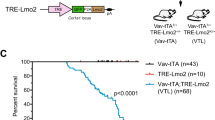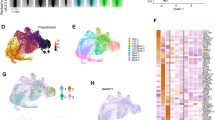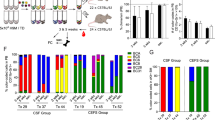Abstract
The t(6;9)-positive acute myeloid leukemia (AML) is classified as a separate clinical entity because of its early onset and poor prognosis. The hallmark of t(6;9) AML is the expression of the DEK/CAN fusion protein. The leukemogenic potential of DEK/CAN has been called into question, because it was shown to be unable to block the differentiation of hematopoietic progenitors. We found that DEK/CAN initiated leukemia from a small subpopulation within the hematopoietic stem cell (HSC) population expressing a surface marker pattern of long-term (LT) HSC. The propagation of established DEK/CAN-positive leukemia was not restricted to the LT-HSC population, but occurred even from more mature and heterogeneous cell populations. This finding indicates that in DEK/CAN-induced leukemia, there is a difference between ‘leukemia-initiating cells’ (L-ICs) and ‘leukemia-maintaining cells’ (L-MCs). In contrast to the L-IC cells represented by a very rare subpopulation of LT-HSC, the L-MC seem to be represented by a larger and phenotypically heterogeneous cell population.
This is a preview of subscription content, access via your institution
Access options
Subscribe to this journal
Receive 12 print issues and online access
$259.00 per year
only $21.58 per issue
Buy this article
- Purchase on Springer Link
- Instant access to full article PDF
Prices may be subject to local taxes which are calculated during checkout






Similar content being viewed by others
References
Passegué E, Jamieson CHM, Ailles LE, Weissman IL . Normal and leukemic hematopoiesis: are leukemias a stem cell disorder or a reacquisition of stem cell characteristics? Proc Natl Acad Sci USA 2003; 100: 11842–11849.
Look AT . Oncogenic transcription factors in the human acute leukemias. Science 1997; 278: 1059–1064.
Puccetti E, Obradovic D, Beissert T, Bianchini A, Washburn B, Chiaradonna F et al. AML-associated translocation products block vitamin D(3)-induced differentiation by sequestering the vitamin D(3) receptor. Cancer Res 2002; 62: 7050–7058.
Yan M, Kanbe E, Peterson LF, Boyapati A, Miao Y, Wang Y et al. A previously unidentified alternatively spliced isoform of t(8;21) transcript promotes leukemogenesis. Nat Med 2006; 12: 945–949.
Zheng X, Beissert T, Kukoc-Zivojnov N, Puccetti E, Altschmied J, Strolz C et al. Gamma-catenin contributes to leukemogenesis induced by AML-associated translocation products by increasing the self-renewal of very primitive progenitor cells. Blood 2004; 103: 3535–3543.
Shearer BM, Knudson RA, Flynn HC, Ketterling RP . Development of a D-FISH method to detect DEK/CAN fusion resulting from t(6;9)(p23;q34) in patients with acute myelogenous leukemia. Leukemia 2005; 19: 126–131.
Soekarman D, von Lindern M, van der Plas SDC, Selleri L, Bartram C, Martiat P et al. Dek-can rearrangment in translocation (6;9)(p23;q34). Leukemia 1992; 6: 489–494.
Chi Y, Lindgren V, Quigley S, Gaitonde S . Acute myelogenous leukemia with t(6;9)(p23;q34) and marrow basophilia: an overview. Arch Pathol Lab Med 2008; 132: 1835–1837.
Garçon L, Libura M, Delabesse E, Valensi F, Asnafi V, Berger C et al. DEK-CAN molecular monitoring of myeloid malignancies could aid therapeutic stratification. Leukemia 2005; 19: 1338–1344.
von Lindern M, Fornerod M, van Baal S, Jaegle M, de Wit T, Buijs A et al. The translocation (6;9), associated with a specific subtype of acute myeloid leukemia, results in the fusion of two genes, dek and can, and the expression of a chimeric, leukemia-specific dek-can mRNA. Mol Cell Biol 1992; 12: 1687–1697.
Oyarzo MP, Lin P, Glassman A, Bueso-Ramos CE, Luthra R, Medeiros LJ . Acute myeloid leukemia with t(6;9)(p23;q34) is associated with dysplasia and a high frequency of flt3 gene mutations. Am J Clin Pathol 2004; 122: 348–358.
Hollenbach AD, McPherson CJ, Mientjes EJ, Iyengar R, Grosveld G . Daxx and histone deacetylase II associate with chromatin through an interaction with core histones and the chromatin-associated protein Dek. J Cell Sci 2002; 115: 3319–3330.
Ko SI, Lee IS, Kim JY, Kim SM, Kim DW, Lee KS et al. Regulation of histone acetyltransferase activity of p300 and PCAF by proto-oncogene protein DEK. FEBS Lett 2006; 580: 3217–3222.
Kappes F, Scholten I, Richter N, Gruss C, Waldmann T . Functional domains of the ubiquitous chromatin protein DEK. Mol Cell Biol 2004; 24: 6000–6010.
Waldmann T, Eckerich C, Baack M, Gruss C . The ubiquitous chromatin protein DEK alters the structure of DNA by introducing positive supercoils. J Biol Chem 2002; 277: 24988–24994.
Wise-Draper TM, Allen HV, Thobe MN, Jones EE, Habash KB, Münger K et al. The human DEK proto-oncogene is a senescence inhibitor and an upregulated target of high-risk human papillomavirus E7. J Virol 2005; 79: 14309–14317.
Fornerod M, van Deursen J, van Baal S, Reynolds A, Davis D, Murti KG et al. The human homologue of yeast CRM1 is in a dynamic subcomplex with CAN/Nup214 and a novel nuclear pore component Nup88. EMBO J 1997; 16: 807–816.
Boer J, Bonten-Surtel J, Grosveld G . Overexpression of the nucleoporin CAN/NUP214 induces growth arrest, nucleocytoplasmic transport defects, and apoptosis. Mol Cell Biol. 1998; 18: 1236–1247.
Ageberg M, Gullberg U, Lindmark A . The involvement of cellular proliferation status in the expression of the human proto-oncogene DEK. Haematologica 2006; 91: 268–269.
Beissert T, Hundertmark A, Kaburova V, Travaglini L, Mian AA, Nervi C et al. Targeting of the N-terminal coiled coil oligomerization interface by a helix-2 peptide inhibits unmutated and imatinib-resistant BCR/ABL. Int J Cancer 2008; 122: 2744–2752.
Zheng X, Seshire A, Rüster B, Bug G, Beissert T, Puccetti E . Arsenic but not all-trans retinoic acid overcomes the aberrant stem cell capacity of PML/RARalpha-positive leukemic stem cells. Haematologica 2007; 92: 323–331.
Bug G, Gül H, Schwarz K, Pfeifer H, Kampfmann M, Zheng X et al. Valproic acid stimulates proliferation and self-renewal of hematopoietic stem cells. Cancer Res 2005; 65: 2537–2541.
Huntly BJP, Shigematsu H, Deguchi K, Lee BH, Mizuno S, Duclos N et al. MOZ-TIF2, but not BCR-ABL, confers properties of leukemic stem cells to committed murine hematopoietic progenitors. Cancer Cell 2004; 6: 587–596.
Coulombel L . Identification of hematopoietic stem/progenitor cells: strength and drawbacks of functional assays. Oncogene 2004; 23: 7210–7222.
Deshpande AJ, Cusan M, Rawat VPS, Reuter H, Krause A, Pott C et al. Acute myeloid leukemia is propagated by a leukemic stem cell with lymphoid characteristics in a mouse model of CALM/AF10-positive leukemia. Cancer Cell 2006; 10: 363–374.
Viale A, Franco FD, Orleth A, Cambiaghi V, Giuliani V, Bossi D et al. Cell-cycle restriction limits DNA damage and maintains self-renewal of leukaemia stem cells. Nature 2009; 457: 51–56.
Guibal FC, Alberich-Jorda M, Hirai H, Ebralidze A, Levantini E, Ruscio AD et al. Identification of a myeloid committed progenitor as the cancer-initiating cell in acute promyelocytic leukemia. Blood 2009; 114: 5415–5425.
Wojiski S, Guibal FC, Kindler T, Lee BH, Jesneck JL, Fabian A et al. PML-RARalpha initiates leukemia by conferring properties of self-renewal to committed promyelocytic progenitors. Leukemia 2009; 23: 1462–1471.
Wang JC, Dick JE . Cancer stem cells: lessons from leukemia. Trends Cell Biol 2005; 15: 494–501.
Acknowledgements
This work was funded by a grant from Deutsche Krebshilfe e.V. to Martin Ruthardt (107741). MR is further funded by grants from German José Carreras Leukemia-Foundation (together with RH—DJCLS—R 07/27f), Deutsche Forschungsgemeinschaft (DFG-RU 728/3-2) and Alfred and Angelika Gutermuth Foundation.
Author information
Authors and Affiliations
Corresponding author
Ethics declarations
Competing interests
The authors declare no conflict of interest.
Additional information
Supplementary Information accompanies the paper on the Leukemia website
Rights and permissions
About this article
Cite this article
Oancea, C., Rüster, B., Henschler, R. et al. The t(6;9) associated DEK/CAN fusion protein targets a population of long-term repopulating hematopoietic stem cells for leukemogenic transformation. Leukemia 24, 1910–1919 (2010). https://doi.org/10.1038/leu.2010.180
Received:
Revised:
Accepted:
Published:
Issue Date:
DOI: https://doi.org/10.1038/leu.2010.180
Keywords
This article is cited by
-
Activation of signaling pathways in models of t(6;9)-acute myeloid leukemia
Annals of Hematology (2022)
-
Transformation of human CD34+ hematopoietic progenitor cells with DEK-NUP214 induces AML in an immunocompromised mouse model
Oncogene (2016)
-
The DEK oncoprotein and its emerging roles in gene regulation
Leukemia (2015)
-
Forced expression of the DEK-NUP214 fusion protein promotes proliferation dependent on upregulation of mTOR
BMC Cancer (2013)
-
Leukemia-associated antigens and their relevance to the immunotherapy of acute myeloid leukemia
Leukemia (2012)



